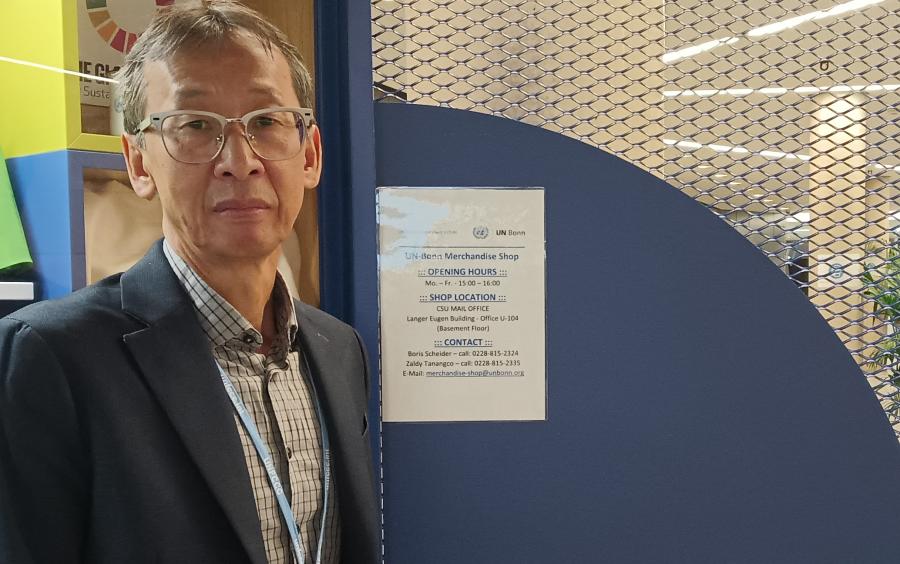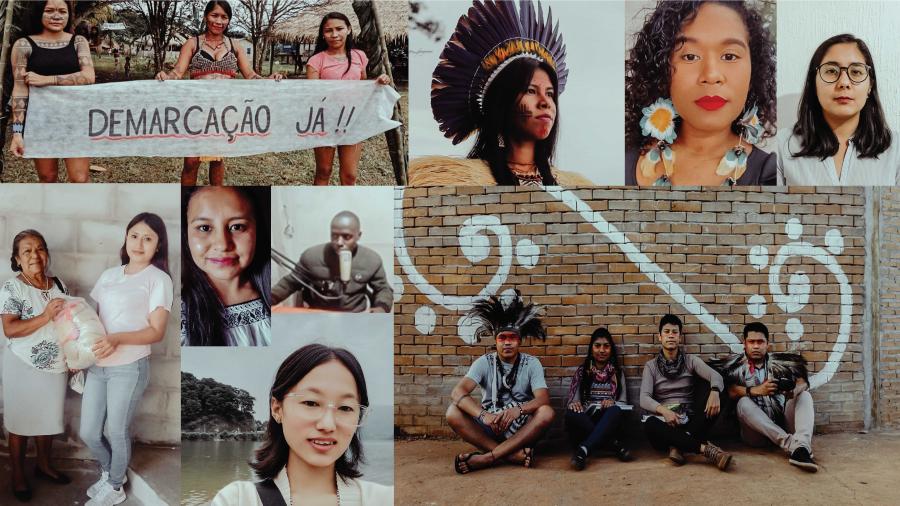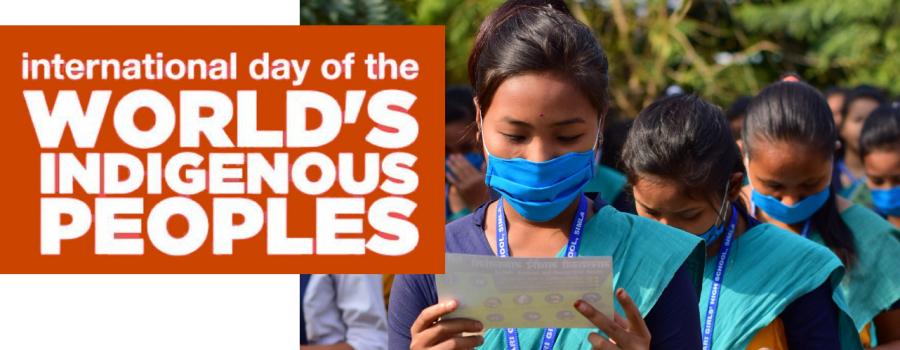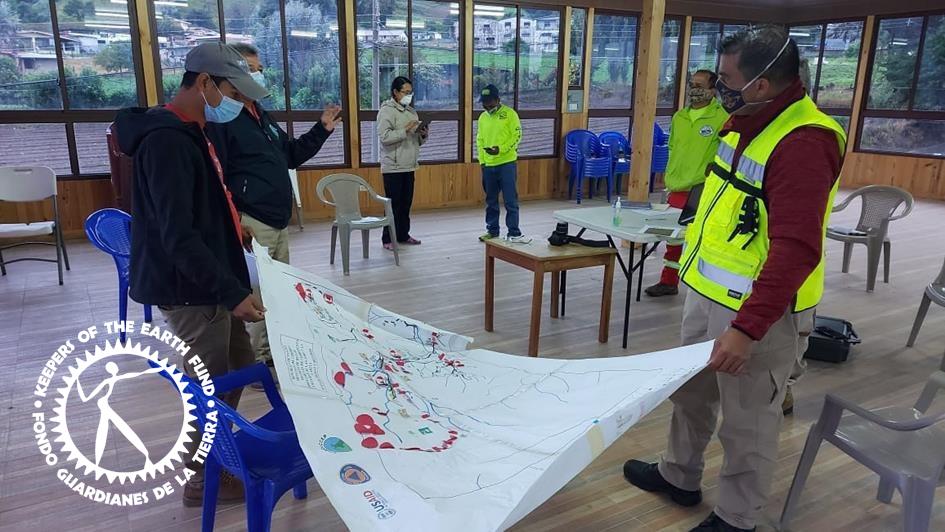
The Keepers of the Earth Fund is an Indigenous Led Fund designed to support Indigenous Peoples’ community development and advocacy projects. Since 2017, KOEF has supported 177 projects in 35 countries totaling $764,317. KOEF provides small grants to grassroots Indigenous-led communities, organizations, and traditional governments to support their self-determined development projects based on their Indigenous values. Predicated on the United Nations Declaration on the Rights of Indigenous Peoples, Cultural Survival uses a rights-based approach in our grantmaking strategies to support grassroots Indigenous solutions through the equitable distribution of resources to Indigenous communities.
We are excited to share that this year through KOEF, we were able to support 53 Indigenous-led projects in 17 countries, with total funding of $263,608. The projects supported were developed by Indigenous communities in three core areas: Indigenous grassroots solutions to climate change; a response to the COVID-19 pandemic in relation to food sovereignty, economy, and community health; and relief efforts from the impacts of Hurricanes Eta and Iota, which struck Central America in November 2020.
These grants have been made possible through the generous support to our Keepers of the Earth Fund by the MacArthur Foundation, the Ray Anderson Foundation, and the Swift Foundation. Please consider making a gift to Cultural Survival to invest in our Indigenous Led Funds so we can continue to address climate change, resource Indigenous self-determination and support Indigenous Peoples' development.
Cultural Survival is proud to announce the following grant partners:
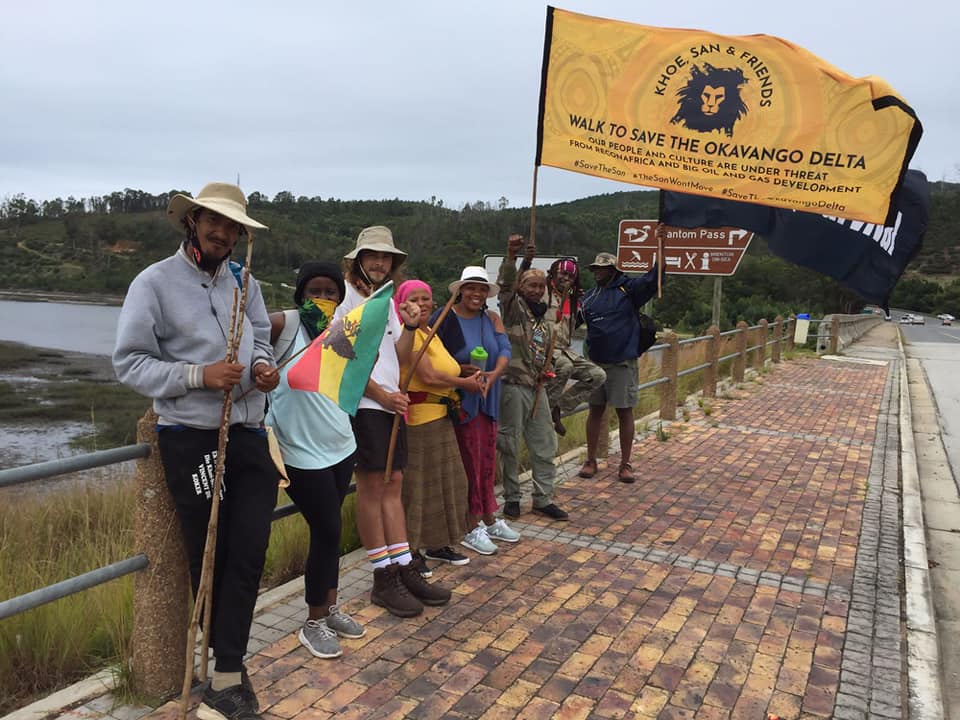
First People Southern Africa (FPSA)'s Indigiwalk.
Fighting and Mitigating Climate Change through Indigenous Solutions
International Indigenous Fund for Development and Solidarity "Batani" - Dolgan, Nenet, Nganasan, Evenk, Enet, and Sami (United States and Russia)
Russian company Norilsk Nickel is the world's largest producer of palladium and one of the largest producers of nickel, platinum, cobalt, and copper. Norilsk Nickel is also one of the worst environmental polluters in the world. By the end of May 2020, Norilsk Nickel spilled 21,000 tons of diesel into the Ambarnaya River in Russia. Most of the company’s activities take place in Taimyr, home to Dolgan, Nenet, Nganasan, Evenk, and Enet Indigenous Peoples. The project, "Indigenous Peoples-Led Advocacy for Prioritizing Subsistence, Rights, and Culture over Extractivism,” will establish a dialogue with German company BASF and others that have contracts with Norilsk Nickel to advocate for compliance with the international human rights of Indigenous Peoples.
Artisan Women from Santa Rosa - Qom (Paraguay)
In the Chaco region, the community of Santa Rosa faces a multinational megaproject that wants to impose large-scale eucalyptus cultivation in their territory. As a way of defending their territory, women of the community are raising awareness and empowering themselves. This project is working to return to the cultivation of totora (a plant used for handicrafts), to establish a nursery with medicinal plants, and to reforest the territory with native fruit trees that are the base of the local diet. The project will benefit 71 families and 160 Qom people.
Makxtum Kglahaw Chuchutsipi - Tutunaku (Mexico)
Building on the work developed last year with the support of a Keepers of the Earth Fund grant, Makxtum Kglahaw Chuchutsipi will acquire two mobile solar power plants and batteries to install in four houses in Puebla, located in San Mateo Tlacotepec, Altica, San Felipe Tepatlán, and Olintla. Last year, a group of youth learned about conventional energy systems and solar renewable energy to explore how to build energy sovereignty in their communities. Twenty Tutunaku youth will take part in the project this year, with the goal of becoming independent from the big enterprises that control energy production and threaten their territories.
Culture and Environment Committee from the Community Council of Barú - Afrodescendant Barú (Colombia)
This project seeks to implement a new learning strategy among Barú children and teens from the Caribbean region, rooted in traditional knowledge of local lands. An ongoing dialogue with knowledge keepers from the Barú community will be established through workshops about the significance of cultural traditions, the preservation of ecosystems like mangroves, and the importance of ecosystem services in the territory for life in the community. These activities will directly benefit 30 children and youth by uniting generations to help fight deterioration of ecosystems and the loss of Barú knowledge.
Amazonian Commune Organization - Kichwa, Shuar, Sapara, Achuar, and Quijo (Ecuador)
The Amazonian Commune identified the need to strengthen local leadership to address cultural loss and land defense due to the high rates of youth emigration to cities. To address this outward migration, Amazonian Commune is organizing a course for young people to build leadership, organizational, and management skills, and to promote land defense and cultural pride. The course will benefit youth from different Indigenous nationalities from the Ecuadorian Amazon, with recognition from Confederación de Nacionalidades Indígenas del Ecuador (CONAIE), Confederación de Nacionalidades Indígenas de la Amazonia Ecuatoriana (CONFENIAE), and the Amazonian Commune.
Association of the Karão Jaguaribaras People - Karão Jaguaribaras (Brazil)
The Povo Karão Jaguaribaras community in Ceará decided to take action on the environmental devastation of their territory. They will organize a series of meetings and workshops to raise awareness about harmful practices such as wildfires, abusive application of pesticides, and deforestation. In coordination with other institutions, they will also undertake ethno-mapping of their lands. The project will benefit 30 families, or 120 Karão Jaguaribaras people, who will build their knowledge, practices, and skills, and awareness of their responsibilities to the environment in which they live.
Playa de Oro Commune - Afrodescendant (Ecuador)
In Esmeraldas, Ecuador, the Afrodescendant Commune Playa de Oro identified the need to protect the Chocó-Esmeralda tropical forest, the heart of their territory, from threats such as mining, logging, and hunting. Their project will improve the security and protection of ancestral lands that are home to many species of flora and fauna. The project will benefit 82 families and preserve over 100 square kilometers of remnant forest.
Coordination of Indigenous Peoples and Organizations of the Noreste, Minas Gerais and Espírito Santo (APOINME) - Anacé, Atikum, Caboclos, Fulkaxó, Fulni-ô, Gamela +53 (Brazil)
APOINME is an organization created by Indigenous leaders in the eastern and northeastern regions of Brazil to defend and secure Indigenous and land rights. In 2006, APOINME created the Indigenous Women Commission with representation from all regions. APOINME will organize two meetings of 40 women leaders from the 10 micro-regions, who represent over 213,000 Indigenous people. The meetings will provide a space for dialogue, training, and exchange of experiences of Indigenous women in each region. The leaders aim to draft a plan for joint actions to address the difficulties and challenges Indigenous Peoples face under the current political and health climate. The results of this project will guide the actions of APOINME.
Sunuwar Sewa Samaj, Sunuwar Welfare Society - Sunuwar (Nepal)
The Sunuwar community in the Bagmati province have raised a number of concerns about the Likhu and Khimti hydropower projects in their territory. Locals do not have access to information about the effects, risks, or revenues of these projects, as is their right according to International Labour Organization Convention 169. The lack of access to information also violates their right to Free, Prior and Informed Consent. The Sunuwar Welfare Society will document the situation in the community and organize at least four informational sessions, to be held in Solukhumbu, Okhaldhunga, Ramechhap, and Dolakha, in order to involve Sunuwar, Sherpa, and other non-Indigenous groups in raising awareness about Indigenous Peoples’ rights.
First People Southern Africa (FPSA) - San (Khwe and !xun) (South Africa/ Namibia/Botswana)
Extraction of natural resources in Indigenous territories is a constant menace to Indigenous Peoples around the world. In the Okavango Delta, a UNESCO World Heritage Site protected due to its high biodiversity, the subsistence of San Tribes is threatened by the explorations of oil company Recon Africa. To bring attention to the issue, First People Southern Africa organized the Indigenous Walk in Defense of the Okavango Delta and its Indigenous communities (#indigiwalk #savetheokavango #savethesan). The walk took place in February 2021 following a route once traveled by Indigenous Peoples from the region, culminating at the Namibian Embassy in South Africa.
Federation of Indigenous and Farmer Organizations from the Azuay (FOA) - Kichwa Kañari (Ecuador)
As an alternative to extractivism in Azuay, the Federation of Indigenous and Farmer Organizations will build six agro-ecological mingas (collaborations) to protect land, water, and biodiversity deteriorated by monocropping and mining projects. Agroecological and organic agriculture techniques and knowledge will be applied by 10 Kichwa Kañari farmers and their families; activities will cover land preparation, sustainable use of water, and agroforestry using materials from the environment and informed by traditional knowledge. An additional 30 families will benefit in a subsequent replication of the project.
San Pedro Jilotepec - Mixe (Mexico)
The Mixe community of San Pedro Jilotepec in Oaxaca will exercise their land rights by obtaining titles to communal lands where they live, strengthening their local government bodies, and engaging women and youth in land management processes. The community will hold planning meetings and land management workshops; create trails, demarcations, and maps; and fulfill the requirements to secure title to their territories.
Indigenous Authorities Council for the Protection of Natural Resources. Raꞌlwaꞌl Uleuꞌ - Maya Kꞌicheꞌ (Guatemala)
With the grant from the Keepers of the Earth Fund, the Authorities Council of San Pedro Jocopilas will start the first stage of a long term project. In this first phase, they will plant pine tree seedlings and carry out maintenance in the forest. In the next stages, they will launch regional reforestation campaigns and will build communal nurseries. Around 800 Maya K’iche’ people will benefit directly, with additional communities benefiting from the conservation work pursued by the Authorities Council in their territory.
National Coalition of Indigenous Peoples (FRENAPI) - Huetar, Maleku, Bribri, Cabécar, Brunca, Ngöbe, Teribe, Chorotega (Costa Rica)
In Heredia, for over 20 years, FRENAPI has been working in defense of Indigenous Peoples’ territories and human rights ensuring that the Indigenous agenda, legislation, and environmental issues are addressed in Costa Rica. At the beginning of 2021, FRENAPI organized a meeting to evaluate the actions taken in 2020 and the consequences of the COVID-19 pandemic on FRENAPI’s partners. Delegates from the eight Indigenous Peoples composing the organization (Huetar, Maleku, Bribri, Cabécar, Brunca, Ngöbe, Teribe, Chorotega) drafted an agenda regarding land defense and reclamation.
Nepali Majhi Mahila Utthan Sangh - Majhi Tribe (Nepal)
As a result of a community consultation in Majhi, Bagmati province, community members identified the need of building the capacity of women and youth in the fields of health, education, leadership in decision-making, as well as raising the overall Majhi community status in Nepal. Nepali Majhi Mahila Utthan Sangh will empower 90 Majhi women and youth in the areas of human rights, leadership skills, and public policies, including the Sustainable Development Goals. Some activities will be conducted in collaboration with local governments and will raise awareness about Indigenous Peoples’ rights.
Tsimaneꞌ Sub Council from the Yacuma Sector - Tsimaneꞌ (Bolivia)
Communities composing the Tsimaneꞌ Sub Council from the Yacuma Sector are facing threats to their land and have been forcefully displaced. They are working to obtain documents that guarantee their right to the territory they live in, to learn about their rights to land as Indigenous people, and to document their ways of life by interviewing local authorities and Elders. Their project, “Territorial Defense in the 11 Communities Belonging to the Tsimaneꞌ Sub Council from the Yacuma Sector,” will work to secure the community’s land rights.
Association of Paĩ Tavyterã Paĩ Retã Joaju Communities - Guaraní Paĩ Tavyterã (Paraguay)
Thirty years ago, the Paĩ Tavyterã people reclaimed Jasuka Venda (Amambay), which consists of about 80 square kilometers. This land is of high importance to the community, as it is their ancestral heritage and place of origin. Since the reclamation, they have occupied and reforested most of the territory. But, conflicts between the community and stock breeders, who want to dispossess Indigenous Peoples of their land, are frequent. In 2020, tensions increased due to militarization in the territory by the Paraguayan State. The Association’s project will continue reforesting the land, strengthen surveillance, improve logistics to monitor borders and entrances, protect springs, and organize communal spaces for discussion and reflection on the dynamics and relation with their land. Approximately 11,000 Paĩ Tavyterã people will directly benefit from the project.
San Juan Quiahije Community - Chat Nya (Mexico)
As a means to raise awareness about the significance of water in the community, the San Juan Quiahije will conduct research on the meanings of water over time through traditional sayings, proverbs, and stories. This information will later be used for an audiovisual and radio program series to be shared in the community through social media and loudspeakers. The community will also organize educational activities about water conservation, including a workshop on building dry toilets. This project will directly benefit around 450 Chat Nya people from San Juan Quiahije.
Federation of Native Maijuna Communities (FECONAMAI) - Maijuna (Peru)
In 2015, after 10 years of FECONAMAI’s hard work, the Peruvian government finally approved the creation of the Maijuna-Kichwa Regional Conservation Area. However, the government now plans to build a 140-kilometer road through the heart of the conservation area, as well as an additional 5-kilometer development corridor on both sides of the road. This proposal has raised suspicions among communities, who think that there are plans for an oil palm plantation. The Peruvian government has not obtained consent for these plans from local communities as required by Peruvian law. FECONAMAI will carry out several activities to guarantee respect for their right to Free, Prior and Informed Consent. Around 6,000 Maijuna will benefit, as their cultural survival is directly tied to the well being of their ancestral lands and biocultural resources.
Community of the Aldeia Jitó - Pankararu (Brazil)
The community of Aldeia Jitó in Pernambuco has been impacted by water scarcity for a long time. Recently, two wells were drilled because of election interests from local political parties. However, the wells were not finished, and material is needed to build the required structure for water extraction. A grant from the Keepers of the Earth Fund will support the completion of one of the wells and will benefit at least 120 Pankararu families.
Association of Indigenous Communities of San Rafael de Velasco (ACISAR-V) - Chiquitano Rafaeleño (Bolivia)
Access to drinking water has been difficult in the Chiquitana region for many years. After the recent wildfires the problem has been exacerbated, and ACISAR-V is working on methods of mitigation and adaptation to climate change by enhancing the resilience of their communities. A pilot project will be implemented to try new technologies for rainwater harvesting, and local youth will interview and document community Elders’ stories about water significance, spring care, and protection of water sources. ACISAR-V will also create educational material on water conservation to raise awareness among children.
Community of La Vega, Cardonal - Hñähñu (Otomi) (Mexico)
Facing the loss of biocultural Hñähñu heritage because of land use change and external influences, the community of La Vega in Hidalgo plans to work towards ensuring intergenerational knowledge transmission for cultural continuity. Several activities will be organized to boost pride and appreciation of the Hñähñu heritage and Otomi language as well as the local natural environment, engaging children, youth, and artisans. Workshops will be held on local production activities in the community. The community is also planning to create a handbook on vegetable and animal species rooted in Indigenous knowledge.
Yurok Tribe Environmental Program (YTEP), Food Sovereignty Division - Yurok (United States)
The Yurok community in California is calling for better land management to fight against the effects of global climate change to increase access to traditional foods and address the rampant food insecurity within the community. The Yurok Tribe Environmental Program will create a map illustrating areas for cultural burning with support from the Yurok Geographic Information Technology. This project will work to combat the effects of global climate change, suppress catastrophic wildfires that seasonally devastate the area, and serve as a model for other Indigenous communities to create their own land management practices. Approximately 6,300 Yurok Tribal members living in or near the Yurok Indian Reservation will benefit from this project.
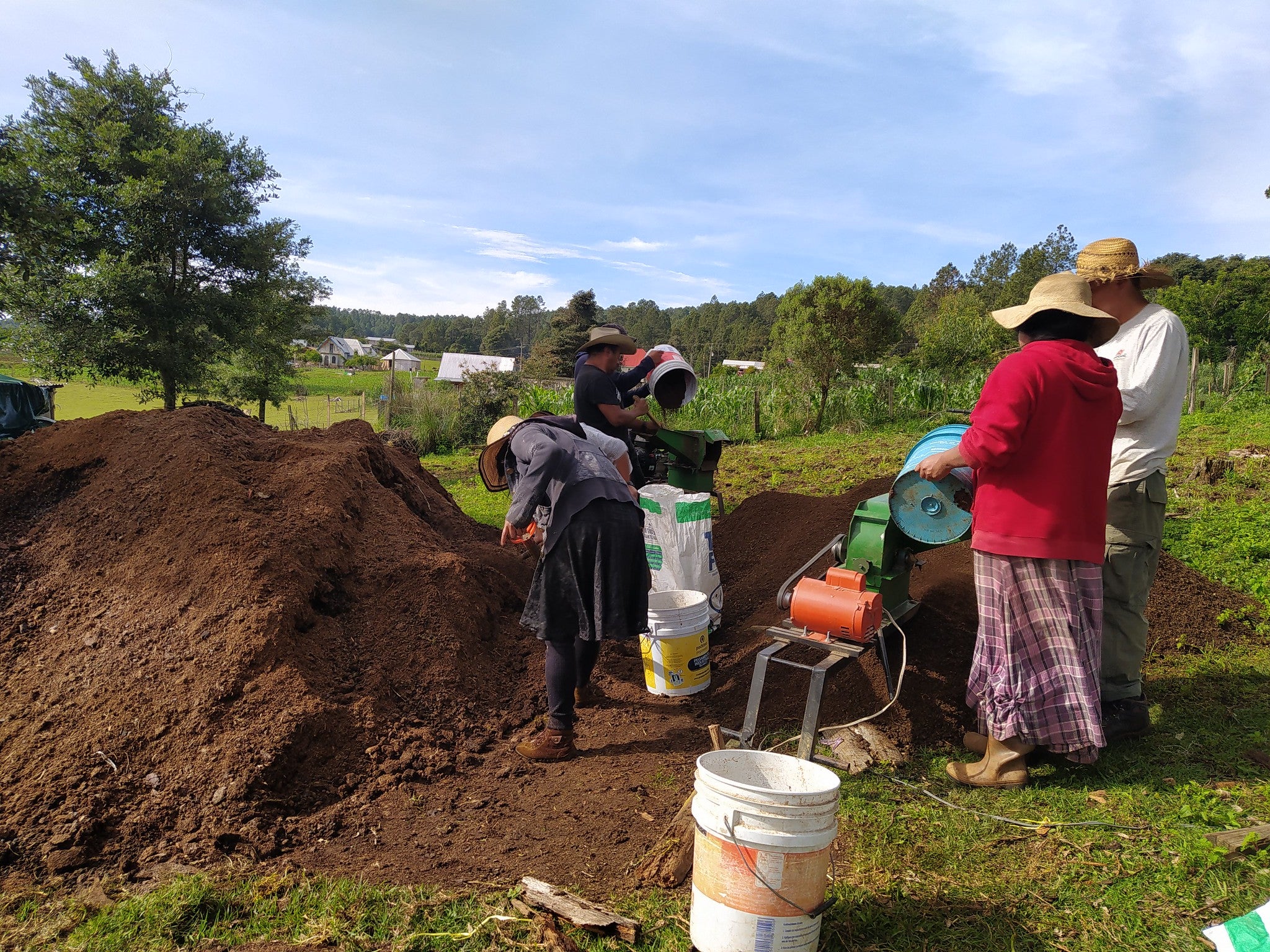
YIMOM Healer Women - Maya Tsotsil (Mexico)
Responding to COVID-19 and Ensuring Food Sovereignty
Sumo-Mayangna Indigenous Women's Government - Mayangna (Nicaragua)
In the north Caribbean coast of Nicaragua, this project will focus on activities that build women’s leadership in the Mayangna Indigenous communities in the Sauni Arungka Sauni As territories. Activities will consist of planting tubers, roots, and basic grains like rice and corn in communal plots to ensure food security for local communities. In total, 60 Mayangna women and their families will benefit. This project aims to diversify foods available for this population, whose way of life is centered around agriculture.
Indigenous Women Organization “Tejiendo Memorias - Auaspa Iuiaikuna” - Kamëntsá and Inga (Colombia)
A group of women from the Kamëntsá and Inga council in the Sibundoy Valley in Putumayo have identified loss of customs and traditions among the Kamëntsá and Inga Peoples as a major issue. They plan to address this problem by protecting the traditional chagra-jajañ as a space for cultural revitalization and ensuring food sovereignty. This women-led project has cultural, agroecological, transformational, and participatory dimensions, and will have an impact on the well being of their families. With activities such as dialogue, trainings, sowing and harvesting, and protection of traditional knowledge, 30 women and their families will benefit.
Xavante Warã Association - Auwe Xavante (Brazil)
On Sangradouro Indigenous land, Xavante cultural practices and traditional plants are being threatened due to the influence and adoption of Western foods. The loss of traditional eating habits and diets have impacted the health of community members. The Xavante Warã Association is addressing this problem through the expansion of community gardens, exchange of traditional seeds, and training of young people in the knowledge of traditional gardening and management of seeds and seedlings. The project will benefit around 150 Auwe Xavante people in Abelhinha village in the Mato-Grosso region.
YIMOM Healer Women - Maya Tsotsil (Mexico)
In the community of Nuevo Corral Chꞌen el Ángel, Chiapas, YIMOM is creating a network of women agroecological producers working towards food sovereignty. They will use techniques such as backyard farming, shade cloth nurseries, rainwater collection, and drip irrigation. Later, crops will be processed for better conservation and use. Women of the community will exercise their right to access and decide how their land is used while generating income through solidarity economy activities. Six Maya Tsotsil families will benefit directly.
Tiquipa community - Aymara (Bolivia)
The food security of the Tiquipa community is threatened because of flooding and pollution of the Karati River. During the rainy season, the river overflows and blocks the paths used by community members to access their arable lands. In other crossing areas in El Alto, Viacha, Pucarani, and Laja villages, the river carries waste and other pollutants, which affects water wells and lands of Aymara communities. The Tiquipa community will organize maintenance works to ensure continuous access to arable lands required for food and economic subsistence.
Association of Remanescentes de Quilombo Rio dos Macacos - Quilombola (Brazil)
Association of Remanescentes de Quilombo Rio dos Macacos’ project was born out of a daily need of the community in Bahia that got worse during the COVID-19 crisis. The Association will conduct collective farming activities to ensure food for 150 Quilombola families. They will buy machinery and seeds and seedlings to start a long term project to ensure food sovereignty for the community. This work will not only guarantee an improvement of nutrition, but may also have a positive financial impact as participants plan to sell part of the harvest for profit.
Sacred Forest Foundation - Shuar, Kichwa y Achuar (Ecuador)
In the Amazonian region in Ecuador, a network will be established between Putuim and Naikim Entsa, two communities at the Morona River basin. The project, with long term and short term goals, will start with the installation of communal gardens to serve as seed banks for medicinal, edible, traditional, and sacred plants, some of which are threatened with extinction. Later, the community will continue exchanging seeds in a network of Indigenous food producers, build a place for an agroecological and artisan fair, acquire means of transport for plants, and hold a workshop on ecologically appropriate agriculture. This project will help with the promotion of traditional knowledge and in combating deforestation. The first stage will benefit 60 Shuar, Kichwa, and Achuar people.
!Garib Nama Heritage Foundation - Khoe and San (South Africa)
Food is a frequent concern for many Indigenous communities. The Khoe and San in Western Cape, after moving to a new location, had to figure out a way to sustain and cultivate their lands. They decided to go back to their ancestral ways of living by farming, and their project will improve the living conditions and social integration of their community with a focus on women’s leadership. They will buy livestock and crop supplies for five participants and, after a period of 18 months, the beneficiaries will donate plants and animals to another 5 women. The project is expected to benefit the entire community with the necessary knowledge and resources to sustain themselves.
Indigenous Council of the Ziora Amena Community - Múrui-Muina (Colombia)
During the COVID-19 pandemic, many Indigenous communities isolated themselves as a preventative measure. However, this had a consequence on income and caused problems with food supply. The Indigenous Council is working to ensure food access in the Ziora Amena community. Due to its proximity to Brazil and the next wave of COVID-19 infections, families were forced into a total quarantine. The community organized themselves to buy food provisions for 20 vulnerable families. In total, 130 Múrui-Muina people benefitted.
Association of Aldeia Kãnã Mihay Pataxó Retirinho - Pataxó (Brazil)
Facing the difficulty of food access during the COVID-19 pandemic, the community of the Aldeia Kãnã Mihay Pataxó Retirinho in Minas Gerais realized that it was critical to ensure food security and to become self-sufficient. Their project consists of improving the community garden and building a chicken coop. The garden, an old community project, will now be repaired and enlarged. The project will benefit about 24 families, or 130 Pataxó people.
Diné Introspective Inc. - Diné (United States)
After the COVID-19 pandemic and the ensuing food crisis in some regions, Diné people in New Mexico realized the importance of continuing traditional agriculture and food sovereignty and maintaining Indigenous healthy eating habits. The program’s goal is to reclaim farming lands by assisting and engaging 20 local youth farmers and community members, who will promote traditional ways of farming to younger generations. They are healing with the land through growing and consuming their own Diné food. The project not only benefits the program participants and local community members, but the whole Navajo Nation, by teaching the youth traditional values of farming, language, and managing their local food sources.
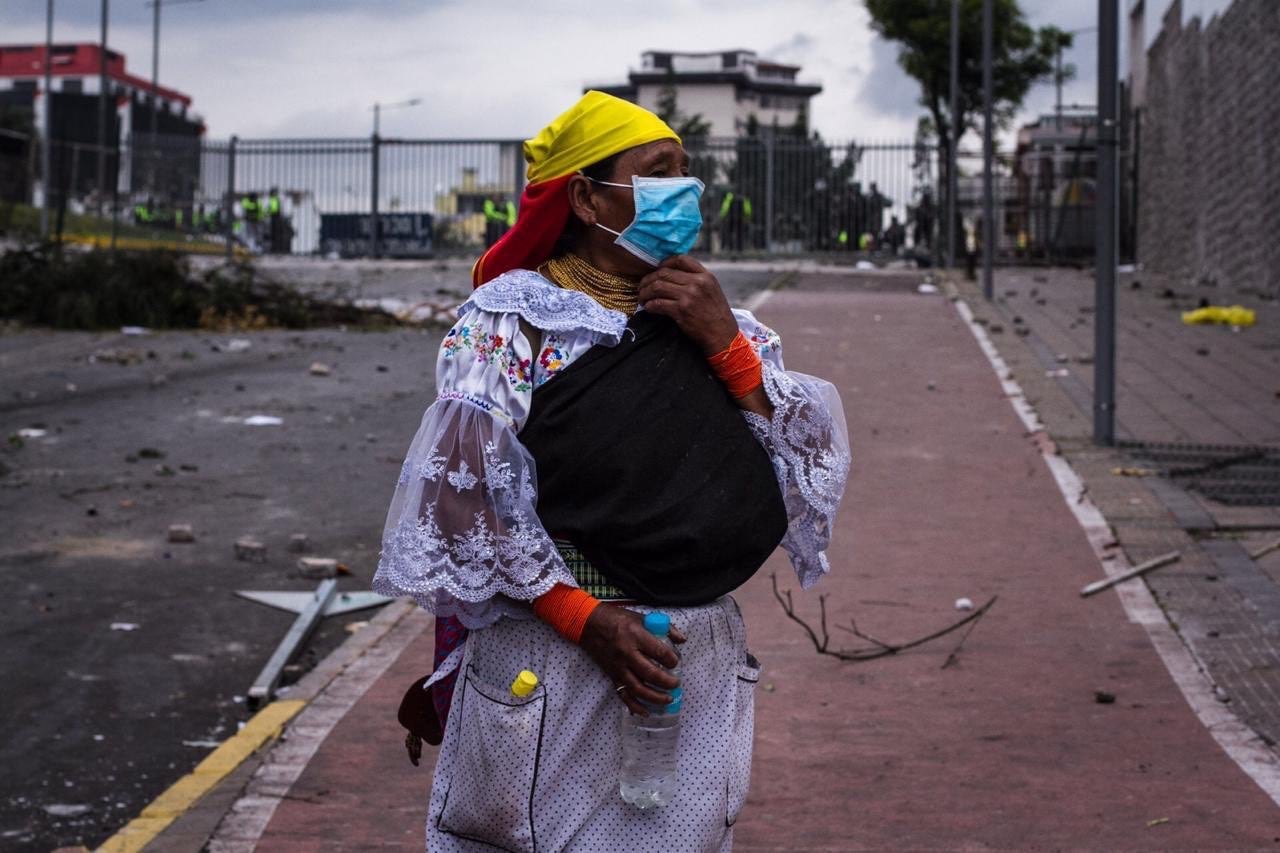
Confederation of Indigenous Nationalities from Ecuador (CONAIE) - Achuar, Cayambi and Awa (Ecuador)
Responding to COVID-19 and Ensuring Community Health
Rural Center of Global Support and Training "Juntos en el camino" (CECACI) - Binnizaꞌ, Ikoojtꞌs, and Anpög (Mexico)
In Santo Domingo Zanatepec, Oaxaca, the communal health center inside the CECACI building is being rehabilitated. Community members are repairing the roof and reconditioning four offices to resume traditional medicine and oral health services for the community. Some areas will be prepared to offer professional training services to health promoters. This project responds to a need expressed in a community after major damage by intense rains and the earthquakes that took place in 2017. With this project, 2500 Binnizaꞌ, Ikoojtꞌs, and Anpög people will benefit.
Marka Cololo Copacabana Antaquilla (MACCANP) - Puquina (Bolivia)
During the COVID-19 pandemic, many people got sick in the Marka Cololo Copacabana Antaquilla. The community has not had access to COVID-19 tests, medical assistance, or treatments for the virus and have relied exclusively on traditional medicine. The goal of this project is to plan an Indigenous-led response to the virus by researching information on traditional and non-traditional practices that have helped to avoid, mitigate, or recover from the symptoms of the virus. Activities include meetings to gather data on the use of traditional and conventional medicines and draft contingency plans.
Confederation of Indigenous Nationalities from Ecuador (CONAIE) - Achuar, Cayambi, and Awa (Ecuador)
Seeing the limitations of the government health system in handling the COVID-19 pandemic, Indigenous Peoples in Ecuador opted to use traditional medicine in treating the virus. CONAIE’s project has been creating materials and methodologies among different Achuar, Cayambi, and Awá communities in the Costa, Sierra, and Amazonia provinces to improve the health and economic crises caused by COVID-19. They held virtual and in-person meetings on ancestral uses of natural medicine and to organize the dissemination of materials in Indigenous languages and the delivery of medicinal plant seeds.
Indigenous Zone of Traditional Councils and Authorities of the Chorrera Amazonas Association (AZICATCH) - Uitoto, Okaina, Bora, and Muinane (Colombia)
After a year and a half of the COVID-19 pandemic in Uitoto, Okaina, Bora, and Muinane communities, many have been infected. AZICATCH decided to use traditional treatments and healing with traditional medicine in 22 communities composing the Asociación Zona Indígena de Cabildos y Autoridades Tradicionales de la Chorrera Amazonas. Their project involves visits to the communities to determine the number of people infected or affected by COVID-19, and doing followups with families using traditional medicine and providing spiritual accompaniment. This systematic work is important to learn from the experiences of community members on best practices in order to make more accurate plans of action for the future.
Association Zihuame Xotlametzin - Nahua (Mexico)
Nahua women from Chilapa and Ahuacuotzingo in the state of Guerrero are still using traditional medicinal plants to treat illnesses. In the face of the health and economic crises caused by the COVID-19 pandemic, the Zihuame Xotlametzin Association identified the need to strengthen traditional medicinal knowledge, as well as promoting women's leadership in their communities. Fifteen women will be trained in women’s rights, ancestral health knowledge, and traditional medicinal knowledge, and natural pharmacies will be made available for communal benefit and use.
Center for Ancestral Medicine Comando Matico Association - Shipibo Konibo (Peru)
The Centro de Medicina Ancestral Comando Matico has been a great example of how important traditional medicine was during the COVID-19 pandemic, which devastated Peru during the first wave. As the Centro worked in nine communities of the Yarinacocha district helping patients with COVID-19 symptoms, they faced obstacles to buying supplies due to shortages and in transporting volunteers and patients. In coordination with the traditional authorities, they are establishing botanical gardens containing all plants used to treat the symptoms of COVID-19. The gardens, located in strategic zones of the region, provide plant medicine to nine communities and benefit 1,000 Shipibo Konibo people.
Indigenous Women of San Rafael Velasco Organization (OMIR-V) - Chiquitano (Bolivia)
In the last two years, Chiquitano communities in Santa Cruz have suffered two health emergencies: the COVID-19 pandemic and serious wildfires in their territories. Due to a lack of attention from the Bolivian State, the communities were forced to face the effects of both emergencies using their natural medicine and traditional knowledge. Luckily, they had a lot of success and want to strengthen their systems for the future. The community documented traditional medicinal knowledge, collected medicinal plants, built a garden, organized workshops, and trained 40 women in traditional health practices. In total, 967 Chiquitano families benefited.
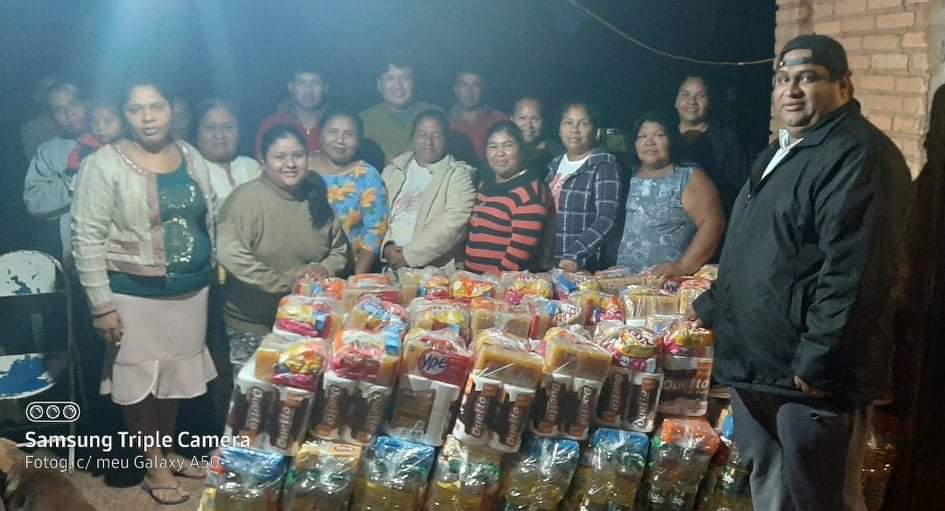
T. I. Índia Vanuíre, Arco-íris - Krenak (Brazil)
Responding to COVID-19 and Building Community Economies
Bananal Guarani Community Assembly - Ava Guaraní (Argentina)
As a response to a need expressed in the APG Bananal Ava Guaraní community in Jujuy, their project will produce concrete bricks to sell while involving local youth. The goal of the project is to reduce the effects of the economic and health crisis caused by COVID-19 in the community. Through this project, they aim to provide employment and avoid the emigration of youth searching for work by promoting their active engagement in creating a future for their families and community.
Córrego João Pereira Indigenous Society - Tremembé (Brazil)
During a training course, the Tremembé community of Córrego João Pereira in Ceará, identified beekeeping as a good source of income generation for the community. Their project is starting apiculture activities, which will provide a source of income and food security to local families. An added advantage is pollination by the bees, which will positively impact fruit farming production. The funds will be used to buy beehives and protective equipment and to build a building for their apiculture work.
Tlalij, Yolojtli Uan Nemililistlij - Nahua and Tenek (Mexico)
In the Huasteca Potosina region, a project in solidarity economy will be implemented to strengthen Nahua and Tenek women’s work. Currently, there are no public spaces for showcasing women’s contributions to the economy and local culture. This project aims to build a space for a solidarity economy, strengthen women’s networks, build their confidence, and promote local cultural and craft traditions. Two hundred women will directly benefit together with their families, and approximately 1,000 Nahua and Tenek people will benefit indirectly.
T. I. Índia Vanuíre, Arco-íris - Krenak (Brazil)
The community of T. I. Índia Vanuíre, Arco-íris, São Paulo produces a large amount of cassava for traditional consumption and carries significant commercial value. Due to the high cost of renting machinery needed to plant and harvest, producers end up with low profits. The community proposed a project to buy the necessary equipment for cassava cultivation so the farmers can increase their earnings. With higher earnings, migration to the cities searching for a job will decrease. The project will benefit 86 Krenak families.
Instituto Munduruku - Munduruku (Brazil)
The idea for this project originated in a community meeting and will address the high cost of building a house in the region inhabited by Munduruku Peoples. Since the cost of wood and its transport has increased in recent years, the community decided to buy a mini sawmill so they can use fallen trees in their forest to build traditional houses for new residents. This way they will spend less money in construction costs and will continue with other activities, such as producing craftwork. The project will serve at least 183 people in Nova Munduruku, Juara Mato Grosso.
South Rupununi Conservation Society - Wapichan and Macushi (Guyana)
The Rupununi region is one of the largest and most pristine biodiversity hotspots in the world, inhabited and protected by Indigenous Peoples like the Wapichan and Macushi. Thanks to traditional practices and stewardship, the land has been managed in a sustainable way for generations. Over the past few decades, village elders have observed that the youth are not learning traditional knowledge, which is in danger of being lost forever. This project seeks to teach the youth traditional skills in cotton spinning, basket weaving, arrow making, and traditional medicine for a sustainable way of life that preserves the environment. In total, 144 persons from 4 communities will directly benefit from this project.
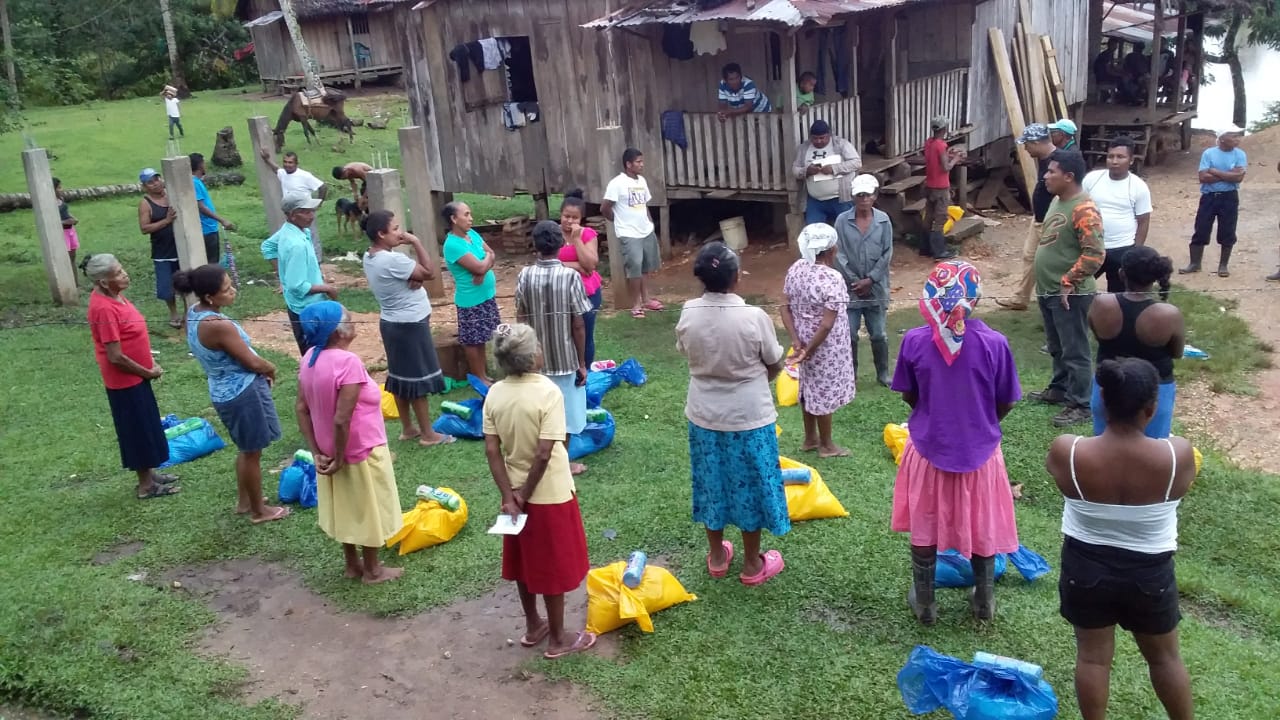
Egdolina Thomas Foundation - Miskito (Nicaragua)
Responding to the Impacts of Hurricanes Iota and Eta
Kalwahai Center - Mayangna (Nicaragua)
The Kalwahai Center, which works for the sustainable development of Indigenous communities in Nicaragua, proposed a project to respond to the damages caused by Hurricanes Iota and Eta, which occurred at the beginning of 2021. After noticing that many roofs had been damaged and that Mayangna families would require support, they repaired houses and planted crops such as beans, corn, and citrus to support 250 people in the Sakalwas, Kilangwas, Wilu, and Ala communities in the municipality of Bonanza, North Caribbean Coast Autonomous Region.
Council of Farmer Union of Guatemala (CUCG) - Qꞌeqchiꞌ (Guatemala)
The year 2020 was hard for many Indigenous communities, especially those in Guatemala, not only due to the COVID-19 pandemic but also because of Hurricanes Iota and Eta. Securing access to food for the most affected communities in the medium and long term was a top priority for CUCG. The CUCG for decades has worked on matters important to Indigenous regions of Guatemala. They will use agroecological techniques to plant vegetables and fruit trees, which will be donated to 32 families from 14 municipalities in Alta Verapaz as part of a long term solution to ensure access to food.
Foundation for Community Holistic Development and Ecosystem Conservation in Panama - Ngäbe Buglé (Panama)
Economic disparities strongly affect Indigenous Peoples. Ngäbe and Buglé people inhabiting Bella Vista and Nuevo Bambito communities in the corregimiento Paso Ancho live in temporary houses in an area at high risk of floods. In 2020, hurricane Eta’s path caused floods and mudslides and destroyed many homes. Because they are not the “owners” of the land they live on, the affected people are excluded from social housing programs. The Foundation for Community Holistic Development and Ecosystem Conservation is undertaking a project to reinforce response to natural disasters of these communities by creating risk maps and training committees on preventive measures, early alert, and evacuation mechanisms.
Garífuna National Council - Garífuna (Belize)
Hurricanes Iota and Eta affected the Garífuna Peoples in southern Belize. As a response to these damages, the Garífuna Council is working on a project to create food security and build community health and well being by promoting farming and consumption of traditional food such as cassava among 25 families from different Garífuna communities. The project will involve women and youth in land preparation, maintenance, and care of the plants, and will benefit directly or indirectly over 1,000 Garífuna people.
Egdolina Thomas Foundation - Miskito (Nicaragua)
After Hurricanes Iota and Eta, the Asang Río Coco community in Waspam needed to reconstruct their means of life and come up with ways to reduce the impact of natural disasters. During the COVID-19 pandemic, the Egdolina Thomas Foundation, together with local community leaders, started a project to strengthen local emergency response systems and community management for youth and community authorities. They are purchasing medicine, disinfection packages, and protective equipment; distributing food; and organizing dialogues on the environmental impact of mining, one of the main problems in the region.
Top photo: Foundation for Community Holistic Development and Ecosystem Conservation in Panama - Ngäbe Buglé
